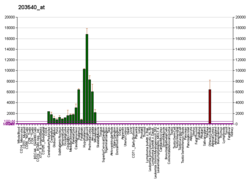Glial fibrillary acidic protein (GFAP) is a protein that is encoded by the GFAP gene in humans.[5] It is a type III intermediate filament (IF) protein that is expressed by numerous cell types of the central nervous system (CNS), including astrocytes[6] and ependymal cells during development.[7] GFAP has also been found to be expressed in glomeruli and peritubular fibroblasts taken from rat kidneys,[8] Leydig cells of the testis in both hamsters[9] and humans,[10] human keratinocytes,[11] human osteocytes and chondrocytes[12] and stellate cells of the pancreas and liver in rats.[13]
GFAP is closely related to the other three non-epithelial type III IF family members, vimentin, desmin and peripherin, which are all involved in the structure and function of the cell's cytoskeleton. GFAP is thought to help to maintain astrocyte mechanical strength[14] as well as the shape of cells, but its exact function remains poorly understood, despite the number of studies using it as a cell marker. The protein was named and first isolated and characterized by Lawrence F. Eng in 1969.[15] In humans, it is located on the long arm of chromosome 17.[16]
- ^ a b c GRCh38: Ensembl release 89: ENSG00000131095 – Ensembl, May 2017
- ^ a b c GRCm38: Ensembl release 89: ENSMUSG00000020932 – Ensembl, May 2017
- ^ "Human PubMed Reference:". National Center for Biotechnology Information, U.S. National Library of Medicine.
- ^ "Mouse PubMed Reference:". National Center for Biotechnology Information, U.S. National Library of Medicine.
- ^ Isaacs A, Baker M, Wavrant-De Vrièze F, Hutton M (July 1998). "Determination of the gene structure of human GFAP and absence of coding region mutations associated with frontotemporal dementia with parkinsonism linked to chromosome 17". Genomics. 51 (1): 152–154. doi:10.1006/geno.1998.5360. PMID 9693047.
- ^ Jacque CM, Vinner C, Kujas M, Raoul M, Racadot J, Baumann NA (January 1978). "Determination of glial fibrillary acidic protein (GFAP) in human brain tumors". Journal of the Neurological Sciences. 35 (1): 147–155. doi:10.1016/0022-510x(78)90107-7. PMID 624958. S2CID 10224197.
- ^ Roessmann U, Velasco ME, Sindely SD, Gambetti P (October 1980). "Glial fibrillary acidic protein (GFAP) in ependymal cells during development. An immunocytochemical study". Brain Research. 200 (1): 13–21. doi:10.1016/0006-8993(80)91090-2. PMID 6998542. S2CID 38131934.
- ^ Buniatian G, Traub P, Albinus M, Beckers G, Buchmann A, Gebhardt R, Osswald H (January 1998). "The immunoreactivity of glial fibrillary acidic protein in mesangial cells and podocytes of the glomeruli of rat kidney in vivo and in culture". Biology of the Cell. 90 (1): 53–61. doi:10.1016/s0248-4900(98)80232-3. PMID 9691426. S2CID 31851422.
- ^ Maunoury R, Portier MM, Léonard N, McCormick D (December 1991). "Glial fibrillary acidic protein immunoreactivity in adrenocortical and Leydig cells of the Syrian golden hamster (Mesocricetus auratus)". Journal of Neuroimmunology. 35 (1–3): 119–129. doi:10.1016/0165-5728(91)90167-6. PMID 1720132. S2CID 3766335.
- ^ Davidoff MS, Middendorff R, Köfüncü E, Müller D, Jezek D, Holstein AF (2002). "Leydig cells of the human testis possess astrocyte and oligodendrocyte marker molecules". Acta Histochemica. 104 (1): 39–49. doi:10.1078/0065-1281-00630. PMID 11993850.
- ^ von Koskull H (1984). "Rapid identification of glial cells in human amniotic fluid with indirect immunofluorescence". Acta Cytologica. 28 (4): 393–400. PMID 6205529.
- ^ Kasantikul V, Shuangshoti S (May 1989). "Positivity to glial fibrillary acidic protein in bone, cartilage, and chordoma". Journal of Surgical Oncology. 41 (1): 22–26. doi:10.1002/jso.2930410109. PMID 2654484. S2CID 34069861.
- ^ Apte MV, Haber PS, Applegate TL, Norton ID, McCaughan GW, Korsten MA, et al. (July 1998). "Periacinar stellate shaped cells in rat pancreas: identification, isolation, and culture". Gut. 43 (1): 128–133. doi:10.1136/gut.43.1.128. PMC 1727174. PMID 9771417.
- ^ Cullen DK, Simon CM, LaPlaca MC (July 2007). "Strain rate-dependent induction of reactive astrogliosis and cell death in three-dimensional neuronal-astrocytic co-cultures". Brain Research. 1158: 103–115. doi:10.1016/j.brainres.2007.04.070. PMC 3179863. PMID 17555726.
- ^ Eng LF, Ghirnikar RS, Lee YL (October 2000). "Glial fibrillary acidic protein: GFAP-thirty-one years (1969-2000)". Neurochemical Research. 25 (9–10): 1439–1451. doi:10.1023/A:1007677003387. PMID 11059815. S2CID 9221868.
- ^ Bongcam-Rudloff E, Nistér M, Betsholtz C, Wang JL, Stenman G, Huebner K, et al. (March 1991). "Human glial fibrillary acidic protein: complementary DNA cloning, chromosome localization, and messenger RNA expression in human glioma cell lines of various phenotypes". Cancer Research. 51 (5): 1553–1560. PMID 1847665.





